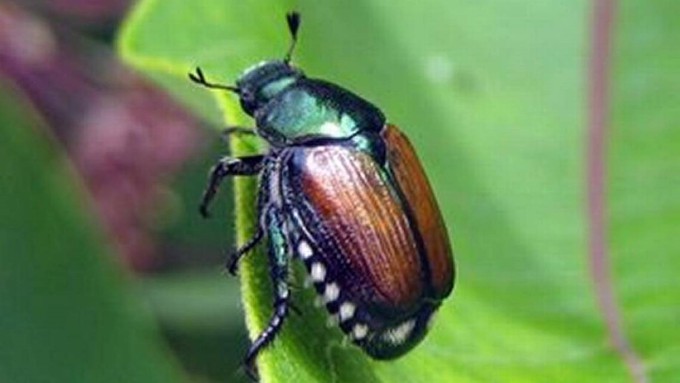
After successful fight against Oriental fruit fly, Sacramento County now battles Japanese beetles

Japanese beetles are small – half the size of a penny – but very hungry. Courtesy of CDFA
State and Sacramento County officials conquered one invasive pest, but another appears to be on the rise.
First, the good news: The California Department of Food and Agriculture (CDFA) has lifted the Oriental Fruit Fly (OFF) quarantine it had in place in Sacramento County. Officially over on May 31, the quarantine had been active for almost eight months and impacted parts of Rancho Cordova, Fair Oaks, Carmichael, Gold River and La Riviera.
Those restrictions were removed just in time for summer harvest season. During the quarantine, produce and plants could not be moved out of the restricted area, impacting commercial nurseries and farm stands. Residents also were urged not to take any fruit, vegetables or plants off their property.
Now the bad news: Japanese beetles – considered among the worst invasive pest – were detected in Carmichael.
On Thursday, Sacramento County posted the news on its official Facebook page:
“An invasive insect pest called the Japanese Beetle has been found in the Carmichael area of Sacramento County,” said the post. “Japanese Beetles can damage over 300 species of ornamental, horticultural, agricultural and native plants, posing a serious threat to our state’s agriculture, environment, and your backyard. Agricultural officials need your cooperation to eliminate this non-native pest.”
State and county ag officials have been actively battling Japanese beetles (Popillia japonica) around Sacramento for almost four years. Between June 4, 2020, and July 6, 2022, they trapped a total of 240 Japanese beetles in the Arden Arcade area and Rancho Cordova. Since then, a 49-square-mile detection area centered around the original findings has been monitored for more beetles and to determine if eradication efforts have been effective.
The beetle’s larvae overwinter in turf grasses, then adult beetles come out in summer to consumer just about everything in sight. These bad bugs can destroy vineyards and orchards. They go crazy over roses.
In 2023, ag officials treated a large area surrounding Del Paso Country Club and its nearby neighborhoods with such pesticides as Acelepryn and beetleGONE! (which uses Bacillus thuringiensis galleriae or BTG). (Japanese beetles love turf grass and golf courses in particular.)
This summer, officials plan to treat a neighborhood roughly bordered by Watt Avenue on the west, Montclaire Street to the east, Lynne Way to the south and French Avenue to the north.
Now, trapping and monitoring efforts will extend to other parts of the county.
“You may see State and County officials in the area setting and checking traps, conducting visual surveys, and performing treatments for Japanese Beetle,” added the county. “Please be on the lookout for these beetles in your neighborhood, in particular in rose bushes as that is a preferred host.”
Looking like little bronze scarabs, Japanese beetles are small – half the size of a penny. Other common bugs such as fig beetles and June bugs have similar green and metallic coloring but are much larger.
“Have you seen the Japanese Beetle in your area?” the county added. “If you do, please call the California Department of Food and Agriculture Exotic Pest Hotline at 1-800-491-1899.”
Also, photos of suspect bugs may be emailed to pesthotline@cdfa.ca.gov.
Learn more: https://www.cdfa.ca.gov/plant/jb/
Comments
0 comments have been posted.Sacramento Digs Gardening to your inbox.
Food in My Back Yard Series
May 6: Maintain soil moisture with mulch for garden success
April 29: What's (already) wrong with my tomato plants?
April 22: Should you stock up on fertilizer? (Yes!)
April 15: Grow culinary herbs in containers
April 8: When to plant summer vegetables
April 1: Don't be fooled by these garden myths
March 25: Fertilizer tips: How to 'feed' your vegetables for healthy growth
March 18: Time to give vegetable seedlings some more space
March 11: Ways to win the fight against weeds
March 4: Potatoes from the garden
Feb. 25: Plant a fruit tree now -- for later
Feb. 18: How to squeeze more food into less space
Feb. 11: When to plant? Consider staggering your transplants
Feb. 4: Starting in seed starting
Sites We Like
Garden Checklist for week of May 11
Make the most of the lower temperatures early in the week. We’ll be back in the 80s by Thursday.
* Plant, plant, plant! It’s prime planting season in the Sacramento area. Time to set out those tomato transplants along with peppers and eggplants. Pinch off any flowers on new transplants to make them concentrate on establishing roots instead of setting premature fruit.
* Direct-seed melons, cucumbers, summer squash, corn, radishes, pumpkins and annual herbs such as basil.
* Harvest cabbage, lettuce, peas and green onions.
* In the flower garden, direct-seed sunflowers, cosmos, salvia, zinnias, marigolds, celosia and asters. (You also can transplant seedlings for many of the same flowers.)
* Plant dahlia tubers.
* Transplant petunias, marigolds and perennial flowers such as astilbe, columbine, coneflowers, coreopsis, dahlias, rudbeckia and verbena.
* Keep an eye out for slugs, snails, earwigs and aphids that want to dine on tender new growth.
* Feed summer bloomers with a balanced fertilizer.
* For continued bloom, cut off spent flowers on roses as well as other flowering plants.
* Add mulch to the garden to maintain moisture. Mulch also cuts down on weeds. But don’t let it mound around the stems or trunks of trees or shrubs. Leave about a 6-inch-to-1-foot circle to avoid crown rot or other problems.
* Remember to weed! Pull those nasties before they set seed.
* Water early in the day and keep seedlings evenly moist.